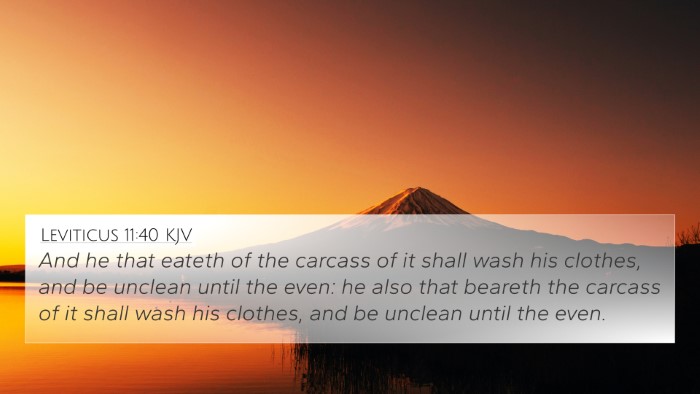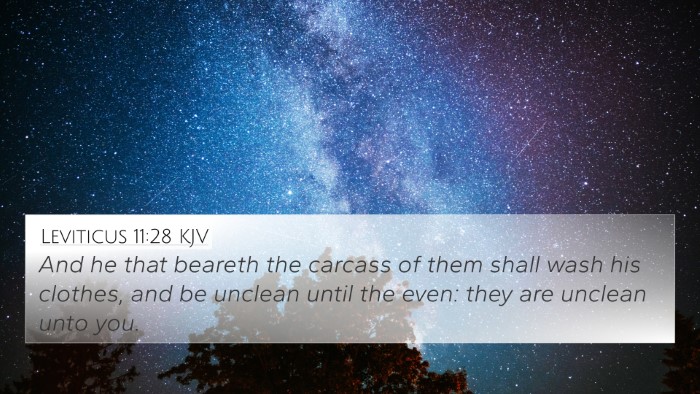Leviticus 11:39 states, “And if any unclean beast die, he that toucheth the carcass of it shall be unclean until the even.” This verse addresses the laws concerning cleanliness and the rituals of purity that were significant in ancient Israelite society. Scholars and commentators, such as Matthew Henry, Albert Barnes, and Adam Clarke, provide insightful interpretations of this scripture, emphasizing its implications for both the physical and spiritual dimensions of life.
Summary of Biblical Insights
The unclean animals mentioned in the surrounding verses symbolize spiritual impurity, and their carcasses represent the consequences of sin. Touching the dead animals signifies a connection to death and impurity, emphasizing the need for the Israelites to maintain their holiness as God's chosen people.
- Matthew Henry's Commentary: Henry stresses that the laws of cleanliness served to teach the Israelites about the importance of spiritual holiness. The unclean animals act as reminders of the separation from sin and the need to avoid things that lead to spiritual death.
- Albert Barnes' Commentary: Barnes highlights the practical aspects of the law, noting that these guidelines fostered a greater awareness of health and cleanliness among the Israelites. By adhering to these laws, they remained aware of how their actions could impact their relationship with God.
- Adam Clarke's Commentary: Clarke points out that the instructions given in Leviticus sought to instill a sense of discipline and reverence towards God. The laws reflect a broader theme throughout the Bible regarding the necessity for believers to maintain purity.
Key Themes and Comparisons
This verse, and others like it, connect profoundly with various themes throughout the Bible, such as purity, holiness, and the consequences of sin. The concept of being defiled by contact with death is reiterated in several other scriptures, establishing a deeper relationship between varied biblical texts. Here are some cross-referenced scriptures that resonate with Leviticus 11:39:
- Numbers 19:11-12: Discusses the need for purification after touching a dead body.
- Deuteronomy 14:8: Provides further details on unclean animals and dietary laws, reinforcing the need for separation from impurity.
- Hebrews 9:14: Highlights how the blood of Christ purifies our conscience from dead works, linking Old Testament laws to New Testament salvation.
- Isaiah 52:11: Calls God’s people to depart from unclean things, resonates with the idea of avoiding spiritual contamination.
- Matthew 23:27-28: Jesus critiques the Pharisees for outward appearances while neglecting inner purity, echoing the principle that external actions reflect internal states.
- 1 Peter 1:16: "Be ye holy; for I am holy," aligns with the call to holiness that Leviticus embodies.
- Revelation 21:27: No unclean thing will enter the heavenly city, affirming the significance of purity in the end times.
The Importance of Cross-Referencing
Cross-referencing biblical texts like Leviticus 11:39 enhances our understanding of the scripture. It allows us to see how these ancient laws relate to modern beliefs and practices. Engaging in a comparative Bible verse analysis can unveil thematic connections and facilitate sermons and teachings.
Tools for Bible Cross-Referencing
Utilizing tools for Bible cross-referencing, such as a Bible concordance or cross-reference guide, can greatly assist in identifying these connections. Such resources enable users to explore related themes and conduct deeper studies into scripture meanings, reinforcing their understanding of biblical teachings.
Conclusion
In summary, Leviticus 11:39 serves as a vital reminder for the community of believers about the necessity of spiritual and physical cleanliness. Through the rich insights provided by commentaries, along with the connections established with other verses, we can grasp the overarching biblical mandate toward holiness and the separation from sin. By cross-referencing and exploring connections between Bible verses, we can enhance our understanding of the scripture and its application to our lives.










